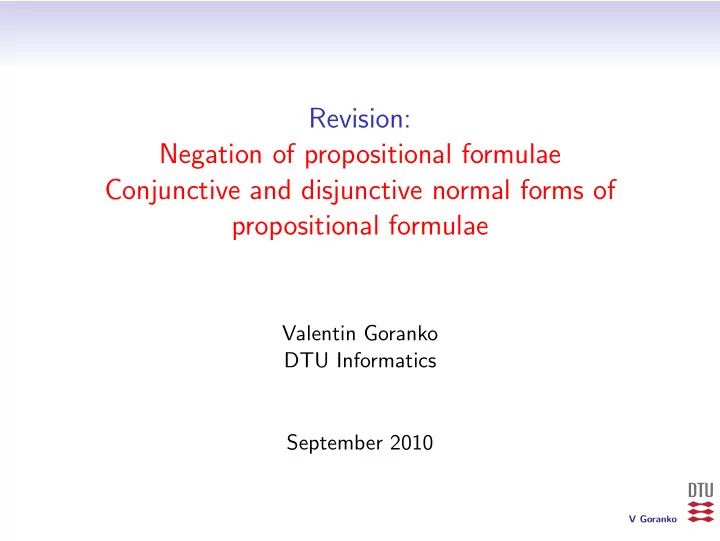

Revision: Negation of propositional formulae Conjunctive and disjunctive normal forms of propositional formulae Valentin Goranko DTU Informatics September 2010 V Goranko
Important equivalences for negations of propositional formulae • ¬¬ A ≡ A , • ¬ ( A ∧ B ) ≡ ¬ A ∨ ¬ B , • ¬ ( A ∨ B ) ≡ ¬ A ∧ ¬ B , • ¬ ( A → B ) ≡ A ∧ ¬ B , • ¬ ( A ↔ B ) ≡ ¬ (( A → B ) ∧ ( B → A )) ≡ ¬ ( A → B ) ∨ ¬ ( B → A ) ≡ ( A ∧ ¬ B ) ∨ ( B ∧ ¬ A ). V Goranko
Negating propositional formulae: example ¬ ( ¬ B → ( ¬ C ∧ D )) ≡ ¬ B ∧ ¬ ( ¬ C ∧ D ) ≡ ¬ B ∧ ( ¬¬ C ∨ ¬ D ) ≡ ¬ B ∧ ( C ∨ ¬ D ) . V Goranko
Normal forms: basic definitions 1. A literal is a propositional variable or its negation. 2. An elementary disjunction (respectively, elementary conjunction ) is a disjunction (respectively, conjunction) of literals. Examples: p , ¬ q , p ∨ ¬ q , p ∨ ¬ p ∨ q ∨ ¬ r are elementary disjunctions; p , ¬ q , ¬ p ∧ q , ¬ p ∧ q ∧ ¬ r ∧ ¬ p are elementary conjunctions. 3. A disjunctive normal form (DNF) is a disjunction of elementary conjunctions. Examples: p , ¬ q , p ∧ ¬ q , p ∨ ¬ q , ( p ∧ ¬ p ) ∨ ¬ q , ( r ∧ q ∧ ¬ p ) ∨ ( ¬ q ∧ p ) ∨ ( ¬ r ∧ p ). 4. A conjunctive normal form (CNF) is a conjunction of elementary disjunctions. Examples: p , ¬ q , p ∧ ¬ q , p ∨ ¬ q , p ∧ ( ¬ p ∨ ¬ q ), ( r ∨ q ∨ ¬ r ) ∧ ¬ q ∧ ( ¬ p ∨ r ). V Goranko
Algorithm for equivalent transformation to CNF/DNF Theorem: Every propositional formula is equivalent to a disjunctive normal form and to a conjunctive normal form. Algorithm transforming a formula into a DNF, respectively CNF: 1. Eliminate all occurrences of ↔ and → using the logical equivalences A → B ≡ ¬ A ∨ B , A ↔ B ≡ ( A → B ) ∧ ( B → A ) . 2. Import all negations in front of the propositional variables, using the logical equivalences listed above. 3. For a DNF: distribute all conjunctions over disjunctions using p ∧ ( q ∨ r ) ≡ ( p ∧ q ) ∨ ( p ∧ r ) . 4. Respectively, for a CNF: distribute all disjunctions over conjunctions using p ∨ ( q ∧ r ) ≡ ( p ∨ q ) ∧ ( p ∨ r ) . V Goranko
Some useful simplifications Throughout this process the formulae can be simplified by using commutativity, associativity, and idempotency of ∨ and , as well as: ◮ p ∨ ¬ p ≡ ⊤ ; p ∧ ¬ p ≡ ⊥ ; ◮ p ∧ ⊤ ≡ p ; p ∧ ⊥ ≡ ⊥ ; ◮ p ∨ ⊤ ≡ ⊤ ; p ∨ ⊥ ≡ p . V Goranko
Example ( p ∧ ¬ r ) → ( p ↔ ¬ q ) ≡ ¬ ( p ∧ ¬ r ) ∨ (( p → ¬ q ) ∧ ( ¬ q → p )) ≡ ( ¬ p ∨ ¬¬ r ) ∨ (( ¬ p ∨ ¬ q ) ∧ ( ¬¬ q ∨ p )) ≡ ¬ p ∨ r ∨ (( ¬ p ∨ ¬ q ) ∧ ( q ∨ p )) For a DNF we further distribute ∧ over ∨ and simplify: ≡ ¬ p ∨ r ∨ ((( ¬ p ∨ ¬ q ) ∧ q ) ∨ (( ¬ p ∨ ¬ q ) ∧ p )) ≡ ¬ p ∨ r ∨ (( ¬ p ∧ q ) ∨ ( ¬ q ∧ q )) ∨ (( ¬ p ∧ p ) ∨ ( ¬ q ∧ p )) ≡ ¬ p ∨ r ∨ (( ¬ p ∧ q ) ∨ ⊥ ) ∨ ( ⊥ ∨ ( ¬ q ∧ p )) ≡ ¬ p ∨ r ∨ ( ¬ p ∧ q ) ∨ ( ¬ q ∧ p ) . For a CNF we distribute ∨ over ∧ and simplify: ≡ ( ¬ p ∨ r ∨ ¬ p ∨ ¬ q ) ∧ ( ¬ p ∨ r ∨ q ∨ p ) ≡ ( ¬ p ∨ r ∨ ¬ q ) ∧ ( ⊤ ∨ r ∨ q ) ≡ ( ¬ p ∨ r ∨ ¬ q ) ∧ ⊤ ≡ ¬ p ∨ r ∨ ¬ q . V Goranko
Recommend
More recommend